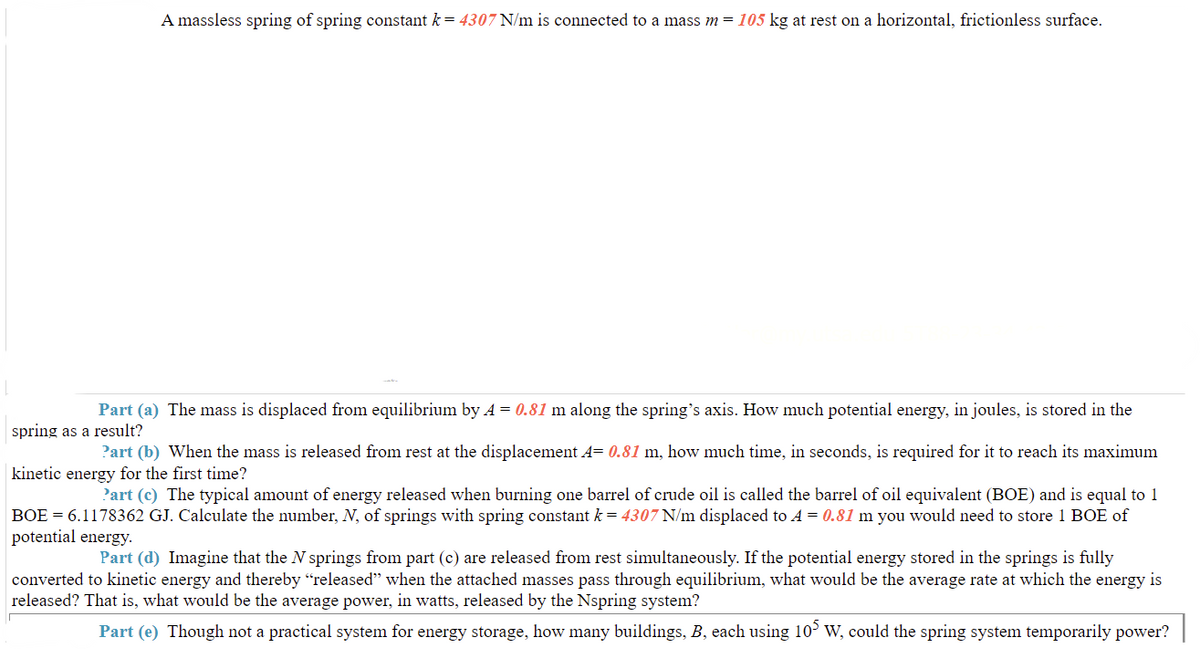A massless spring of spring constant k = 4307 N/m is connected to a mass m = 105 kg at rest on a horizontal, frictionless surface. Part (a) The mass is displaced from equilibrium by A = 0.81 m along the spring's axis. How much potential energy, in joules, is stored in the spring as a result? Part (b) When the mass is released from rest at the displacement A= 0.81 m, how much time, in seconds, is required for it to reach its maximum kinetic energy for the first time? Part (c) The typical amount of energy released when burning one barrel of crude oil is called the barrel of oil equivalent (BOE) and is equal to 1 BOE = 6.1178362 GJ. Calculate the number, N, of springs with spring constant k = 4307 N/m displaced to A = 0.81 m you would need to store 1 BOE of potential energy.
A massless spring of spring constant k = 4307 N/m is connected to a mass m = 105 kg at rest on a horizontal, frictionless surface. Part (a) The mass is displaced from equilibrium by A = 0.81 m along the spring's axis. How much potential energy, in joules, is stored in the spring as a result? Part (b) When the mass is released from rest at the displacement A= 0.81 m, how much time, in seconds, is required for it to reach its maximum kinetic energy for the first time? Part (c) The typical amount of energy released when burning one barrel of crude oil is called the barrel of oil equivalent (BOE) and is equal to 1 BOE = 6.1178362 GJ. Calculate the number, N, of springs with spring constant k = 4307 N/m displaced to A = 0.81 m you would need to store 1 BOE of potential energy.
Related questions
Question

Transcribed Image Text:A massless spring of spring constant k = 4307 N/m is connected to a mass m = 105 kg at rest on a horizontal, frictionless surface.
Part (a) The mass is displaced from equilibrium by A = 0.81 m along the spring's axis. How much potential energy, in joules, is stored in the
spring as a result?
Part (b) When the mass is released from rest at the displacement A= 0.81 m, how much time, in seconds, is required for it to reach its maximum
kinetic energy for the first time?
Part (c) The typical amount of energy released when burning one barrel of crude oil is called the barrel of oil equivalent (BOE) and is equal to 1
|BOE = 6.1178362 GJ. Calculate the number, N, of springs with spring constant k = 4307 N/m displaced to A = 0.81 m you would need to store 1 BOE of
potential energy.
Part (d) Imagine that the N springs from part (c) are released from rest simultaneously. If the potential energy stored in the springs is fully
converted to kinetic energy and thereby "released" when the attached masses pass through equilibrium, what would be the average rate at which the energy is
released? That is, what would be the average power, in watts, released by the Nspring system?
Part (e) Though not a practical system for energy storage, how many buildings, B, each using 10³ W, could the spring system temporarily power?
Expert Solution
This question has been solved!
Explore an expertly crafted, step-by-step solution for a thorough understanding of key concepts.
This is a popular solution!
Trending now
This is a popular solution!
Step by step
Solved in 3 steps
